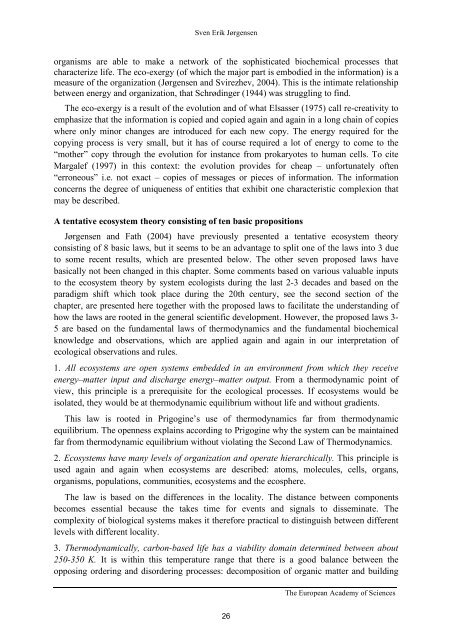An Integrated Ecosystem Theory - European Academy of Sciences
An Integrated Ecosystem Theory - European Academy of Sciences
An Integrated Ecosystem Theory - European Academy of Sciences
You also want an ePaper? Increase the reach of your titles
YUMPU automatically turns print PDFs into web optimized ePapers that Google loves.
Sven Erik Jørgensen<br />
organisms are able to make a network <strong>of</strong> the sophisticated biochemical processes that<br />
characterize life. The eco-exergy (<strong>of</strong> which the major part is embodied in the information) is a<br />
measure <strong>of</strong> the organization (Jørgensen and Svirezhev, 2004). This is the intimate relationship<br />
between energy and organization, that Schrødinger (1944) was struggling to find.<br />
The eco-exergy is a result <strong>of</strong> the evolution and <strong>of</strong> what Elsasser (1975) call re-creativity to<br />
emphasize that the information is copied and copied again and again in a long chain <strong>of</strong> copies<br />
where only minor changes are introduced for each new copy. The energy required for the<br />
copying process is very small, but it has <strong>of</strong> course required a lot <strong>of</strong> energy to come to the<br />
“mother” copy through the evolution for instance from prokaryotes to human cells. To cite<br />
Margalef (1997) in this context: the evolution provides for cheap – unfortunately <strong>of</strong>ten<br />
“erroneous” i.e. not exact – copies <strong>of</strong> messages or pieces <strong>of</strong> information. The information<br />
concerns the degree <strong>of</strong> uniqueness <strong>of</strong> entities that exhibit one characteristic complexion that<br />
may be described.<br />
A tentative ecosystem theory consisting <strong>of</strong> ten basic propositions<br />
Jørgensen and Fath (2004) have previously presented a tentative ecosystem theory<br />
consisting <strong>of</strong> 8 basic laws, but it seems to be an advantage to split one <strong>of</strong> the laws into 3 due<br />
to some recent results, which are presented below. The other seven proposed laws have<br />
basically not been changed in this chapter. Some comments based on various valuable inputs<br />
to the ecosystem theory by system ecologists during the last 2-3 decades and based on the<br />
paradigm shift which took place during the 20th century, see the second section <strong>of</strong> the<br />
chapter, are presented here together with the proposed laws to facilitate the understanding <strong>of</strong><br />
how the laws are rooted in the general scientific development. However, the proposed laws 3-<br />
5 are based on the fundamental laws <strong>of</strong> thermodynamics and the fundamental biochemical<br />
knowledge and observations, which are applied again and again in our interpretation <strong>of</strong><br />
ecological observations and rules.<br />
1. All ecosystems are open systems embedded in an environment from which they receive<br />
energy–matter input and discharge energy–matter output. From a thermodynamic point <strong>of</strong><br />
view, this principle is a prerequisite for the ecological processes. If ecosystems would be<br />
isolated, they would be at thermodynamic equilibrium without life and without gradients.<br />
This law is rooted in Prigogine’s use <strong>of</strong> thermodynamics far from thermodynamic<br />
equilibrium. The openness explains according to Prigogine why the system can be maintained<br />
far from thermodynamic equilibrium without violating the Second Law <strong>of</strong> Thermodynamics.<br />
2. <strong>Ecosystem</strong>s have many levels <strong>of</strong> organization and operate hierarchically. This principle is<br />
used again and again when ecosystems are described: atoms, molecules, cells, organs,<br />
organisms, populations, communities, ecosystems and the ecosphere.<br />
The law is based on the differences in the locality. The distance between components<br />
becomes essential because the takes time for events and signals to disseminate. The<br />
complexity <strong>of</strong> biological systems makes it therefore practical to distinguish between different<br />
levels with different locality.<br />
3. Thermodynamically, carbon-based life has a viability domain determined between about<br />
250-350 K. It is within this temperature range that there is a good balance between the<br />
opposing ordering and disordering processes: decomposition <strong>of</strong> organic matter and building<br />
The <strong>European</strong> <strong>Academy</strong> <strong>of</strong> <strong>Sciences</strong><br />
26


